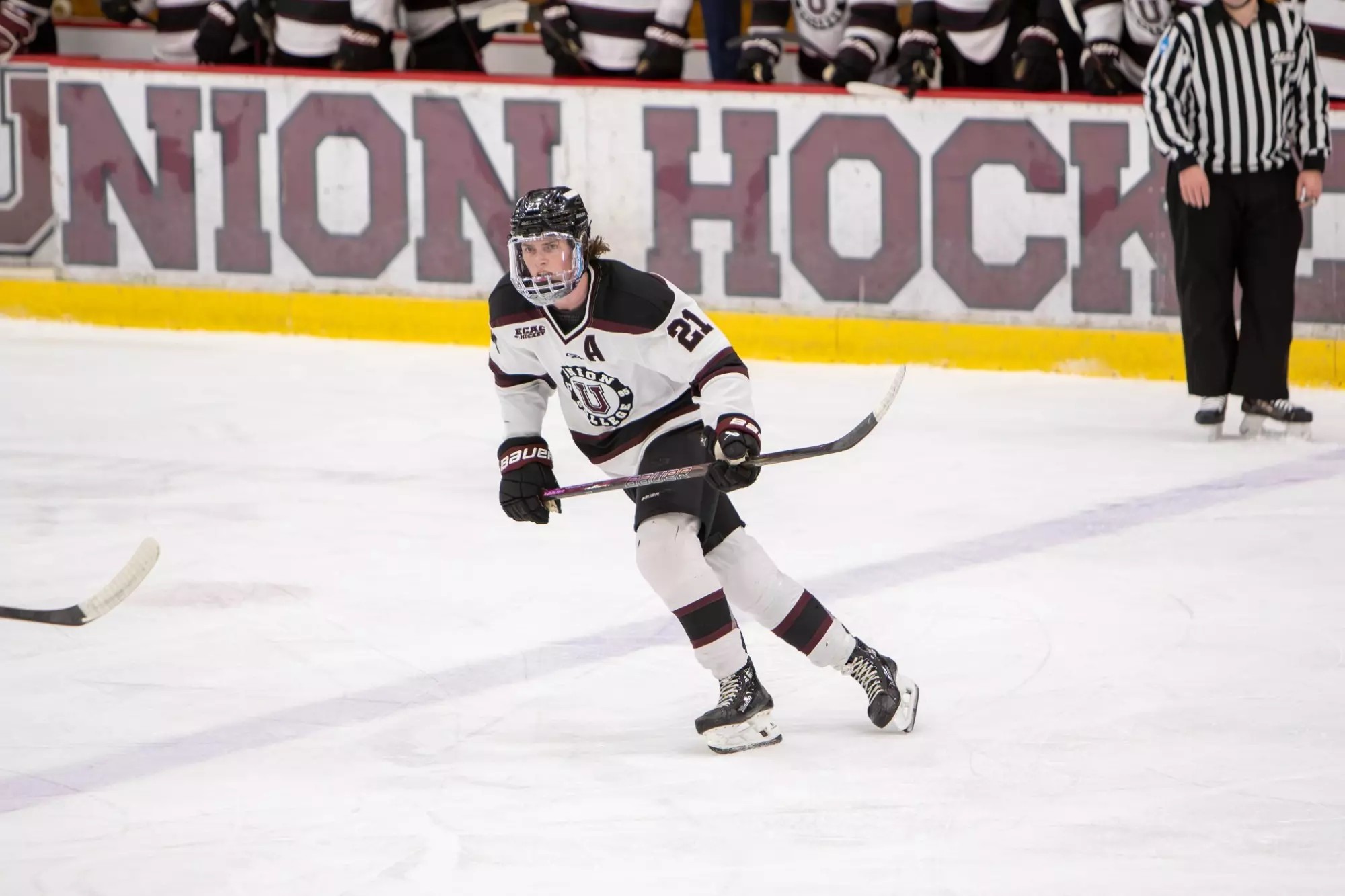The Toronto Maple Leafs dipped their toes into the 2025 UDFA pool today by signing college free-agent defenseman John Prokop.
Prokop, of Union College, will join the Toronto Marlies for the conclusion of their AHL season.
At 6’3, 185 lbs., Prokop fits the same mold that we’ve seen Brad Treliving target repeatedly among defensemen both in NHL transactions and other minor league free agent signings. Last year, it was Boston U’s Cade Webber (6’7); this year, it’s Prokop in the same vein as Philippe Myers at the pro level (6’5). Brad Treliving clearly likes bigger and longer defensemen, and the left-handed Prokop is no exception.
Prokop is a native of Wausau, Wisconsin, and played in the USHL with Omaha, Muskegon, Green Bay, and Des Moines until his 21st birthday. In the USHL, he was not a high scorer, notching a single goal per season and with point totals under a half-point per game. That helped lead Prokop to Union College, which does not play in a power conference and has not been considered a high-level program over the past five years. They won a national championship in 2014 thanks to the brilliance of Shayne Gostisbehere, but the Garnett Chargers (yes, that’s their mascot name) have not been nationally relevant since 2018.
At Union, Prokop’s offense perked up considerably. He scored 20 points in 35 games as a freshman, scoring four goals and earning a spot on the ECAC All-Freshman Team. Prokop then made a significant leap in production, scoring 35 points in 36 games to lead his team in scoring among all positions. He was named first-team All-ECAC, an East region All-American (second team), and he was a nominee for the Hobey Baker Award for the best collegiate player nationally.
That put Prokop on college free-agent radars last time around, but Prokop opted to return to school. Though Union’s on-ice results and record improved a fair bit this past year, Prokop’s counting stat production declined some. It was still very strong, though, as he scored eight goals (identical to the prior year) and 27 points in 36 games — again, he was his team’s highest-scoring defender.
Your author is not an expert on ECAC Hockey (I follow the Big Ten much more closely than the ECAC), but luckily, we have some external resources to learn more on Prokop. From a statistical basis, it’s helpful to know that he was Union’s highest-usage player. 2024-25 was the first season that TOI data was publicly available on College Hockey News, which tells us that Prokop led the way for Union with 24:51, nearly 90 seconds more than the next closest on the team. Though plus/minus is a flawed stat, it’s also notable that Prokop was tied for the best mark on the team at +12.
Looking through the scouting reports, Prokop appeared on a number of the lists of best undrafted free agents for this cycle that were published by the various scouting websites. Corey Pronman of The Athletic had Prokop ranked 12th on his list, first among college defenders (there was one Finnish defenseman higher), noting that Prokop’s size/skating combo makes Prokop attractive to NHL teams. Pronman likes the displayed skill and offense (even if it’s not high-end) while describing the defense as “okay.”
This is where the difference between Prokop and Cade Webber lies. Webber was a big, physical defenseman with pedigree (having been drafted and having played for the USNTDP) who offered almost no offense but was regarded as a defensive specialist on a Boston U D corps that included dynamic puck-movers like Lane Hutson. Prokop, on a lackluster team in comparison to those BU teams, was his team’s version of Lane Hutson, handling transition play and playing on the power play, with the obvious note that his skill is nowhere near Hutson’s. Webber was in the mold of a Philippe Myers stylistically at the collegiate level (or say, Joel Edmundson/Ilya Lyubushkin), while Prokop is something more intriguing altogether.
Chris Peters of FloHockey had Prokop on his list (no ranking) of college undrafted free agents, making the interesting case that Prokop’s improving offense in the NCAA could be a sign of him as a late bloomer:
What is interesting about Prokop is that he’s been a much more productive collegiate player than he was a junior player, suggesting some late-blooming attributes that have helped him. With his skating ability and size, he was going to be on the NHL radar, but his game makes him an especially attractive option in a year with so few obvious undrafted defensemen worth signing.
I think there’s something to the idea that bigger defensemen take longer to figure out their skills at the NHL level (Rasmus Ristolainen could be one example), so it doesn’t seem impossible that the same could have been true for Prokop at a lower level of play. Maybe he needed to grow into his body a little more and become more comfortable with the puck on his stick. Considering what he seems to boast as a skater, to go along with the 6’3 frame, it’s definitely worth a look.
Elite Prospects isn’t as enthusiastic about Prokop, ranking him 20th on their list of college free agents, but he is still the fourth-best defenseman in their eyes. EP likes Prokop’s puck-moving and transitional ability, writing, “(Prokop) can activate into the play, carry the puck, and find open passing targets. He acts as the team’s primary puck distributor at the offensive line, too, creating some tic-tac-toe and backdoor plays.”
Again, EP mentions the mobility and size combo as the central appeal but feels that his mental processing and pace will need to improve for Prokop to hack it at the NHL level. Prokop also appeared in last year’s college free agency guide on that site, and the authors were bearish on Prokop’s wiry frame and physicality while still noting that it gives him more developmental runway.
In totality, you’re looking at a collegiate defenseman with enough mobility and skill to be a legitimate points producer at the NCAA level and enough size and projectable physicality to be attractive to NHL teams. This feels like a good flier for the Maple Leafs to take — a higher upside swing than a Cade Webber. It may take time for Prokop to adjust to the speed and pace of minor league pro hockey, and he may need to learn how to play a more physical game while building muscle in the weight room, but the Leafs have to believe they have an organizational apparatus that can allow him to develop.
With the resources available to players in the sports science department and throughout the franchise, there may be enough for Prokop to perhaps round into something interesting down the road. If nothing else, it’s always a good idea to take a swing or two on a bigger-name college UDFA each offseason, especially given the Leafs‘ general lack of draft picks in recent and future seasons. Now, we’ll see if Toronto signs an undrafted forward (ideally a center) alongside Prokop.














![John Gruden after the Leafs prospects’ 4-1 win over Montreal: “[Vyacheslav Peksa] looked really comfortable in the net… We wouldn’t have won without him” John Gruden, head coach of the Toronto Marlies](https://mapleleafshotstove.com/wp-content/uploads/2025/09/gruden-post-game-sep-14-218x150.jpg)

















![Craig Berube on Joseph Woll leaving the game injured in Carolina: “Hopefully, it is not [serious], but I really liked the way Hildeby came in and handled it” Craig Berube, Toronto Maple Leafs head coach](https://mapleleafshotstove.com/wp-content/uploads/2025/09/berube-pg-sep-21-100x70.jpg)
